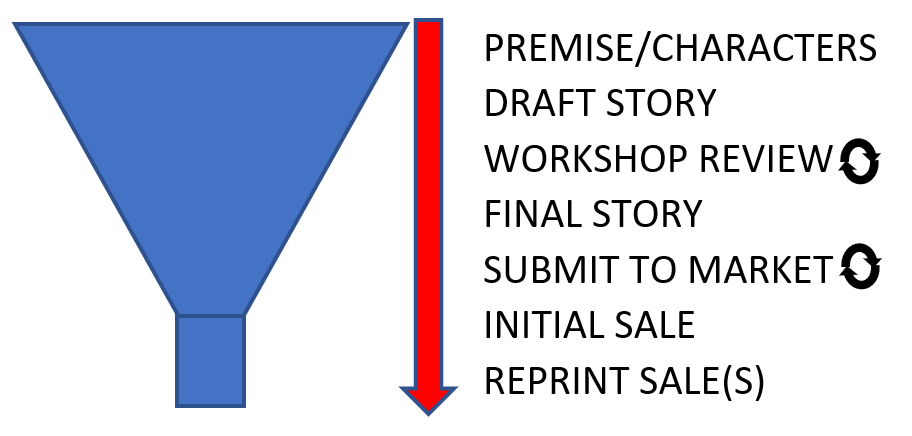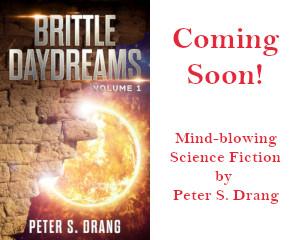In this post I’ll show how to use a funnel model to analyze the writing process for short stories. This will allow any writer to identify what’s impeding their ability to output high quality stories in a timely fashion.
Writing is a Biz, So Use Biz Tools
Businesses have been doing this for years, and writing is a business. Online store owners quickly learn about “The Marketing Funnel.” This is a concept for modeling how to convert store visitors to buyers. For example, you get 1,000 visitors on a given day coming in the top of your “funnel.” Of those, maybe 200 add something to cart, and perhaps only 50 actually complete a purchase. It’s wide at the top (1,000 visitors) and narrows down like a funnel. At each stage, you lose some potential buyers. Store owners analyze this data to see how they can reduce the number of lost opportunities.
The Writing Process Funnel for Short Stories
I apply a similar concept to writing short stories, describing the entire process from initial idea to sale, and even beyond that to post-sale strategies in reprint markets.
So here is Drang’s Short Story FunnelTM:

At each stage of a story’s development, you might “lose” the story. You might start drafting a story and for one reason or another can’t finish it. You might get comments from a workshop that are so daunting you feel the story isn’t salvageable and it’s easier to abandon it and start a new project. There could be many reasons why a story doesn’t make it to the bottom of the funnel.
But just as web store owners try to plug “leaks” in their funnel in order to increase sales, writers should try to optimize their personal writing processes, their story funnels, to increase the output of great, marketable stories.
You’ll note that WORKSHOP REVIEW and SUBMIT TO MARKET have little “cycling arrow” symbols next to them. That indicates that these steps are highly iterative in nature. A workshop review might involve multiple redrafts receiving multiple rounds of review and rework. As anyone who’s tried to break into the short story market knows, the SUBMIT TO MARKET phase of the funnel can go on quite a long time, with rejection letters flooding your inbox!
Now, before I receive angry emails, this is of course a model, not reality, and models are never as nuanced as reality. Sure, I have revised stories after several rejections, but I don’t want to clutter up the model with those kinds of details. Suffice it to say, you might on occasion have to throw a story upward in the funnel to a prior stage.
Using the Writing Process Funnel
How do you use this model to improve your productivity? Like the intrepid web store owner, you first have to keep track of your stats, then look at them and see where you’re losing stories. You then try to determine why that story got lost, and come up with strategies to reduce those losses. You can also identify your bottlenecks. Is your productivity hampered because you don’t have enough ideas? Because you start writing stories then never finish them? Because you finish them but never seem to find time to go back and do those crucial final edits? Understanding where the losses occur and what’s stopping a smooth laminar flow of stories through the funnel is the first step toward figuring out how to limit those losses.
My Current Funnel’s Pipeline
I will have future blog posts on each one of the phases shown in the model. For now, let me show you my current story pipeline as an example.
NOTE: This is my current pipeline, which shows a snapshot of how many stories live in each stage of the funnel. It’s not the dropout stats on my funnel (i.e. what percentage of stories get lost at each step over a given period of time). That will come in a future blog post.
- PREMISE/CHARACTERS: 16
- These are the basic ideas for a story. I keep them in a file called IDEAS. Whenever I have a new idea (usually I start with a premise or a character, an actual plot may come much later) I write it down in that file. These are the incoming story kernels in my funnel.
- In a future blog I’ll tell you where my ideas generally come from and how I can usually force myself to come up with an idea.
- This list gets a few new items almost every week, I have plenty of ideas. This is not my bottleneck.
- DRAFT STORIES: 3
- These are stories I have drafted but I do not yet feel are solid enough for workshop review. Stories typically only stay in this state for a short time for me. Sometimes just one day, sometimes a week, rarely two weeks. I tend to write first drafts pretty quickly, about 1,000 words per hour.
- Why would I have more than one story in draft at any given time? Because I may not have decided how to proceed on some plot point, I’ve decided I need to do some research or consult with someone on some of the science ideas, or because I’ve made an initial shot at the story but feel something’s wrong and I’m letting my brain have some “soak time” to figure out the details.
- WORKSHOP REVIEW: 4
- The workshop I use only allows 4 posts at a time and I keep this part of the pipeline full at all times. Some stories are in workshop review only one week, some have required multiple rounds of rewrite/review cycles that could last a month or more.
- You may not use a workshop, you may simply review your work yourself or have friends who are capable of providing real feedback. To me, unless you’re an established Hugo/Nebula award winning pro, a workshop makes sense.
- FINAL STORY: 5
- These stories are completed but I am not submitting them yet. Why would I hold them back? Well, there may be a market I think the story matches which is not currently taking subs. Many markets have limited submission windows. Or I may already have a sub at a market I think is good for the story, and that market doesn’t take simultaneous subs, so I have to wait.
- For example, three of these five stories are flash fiction. There are only a few pro-paying flash fiction markets in SF/F that have reasonable reply times (more on submission strategy in a future blog). I am in “second round” at a couple of them, which means a long waiting period during which I can’t sub new stories to them. So I’m starting to backlog my flash stories. I’d either have to go to semi-pro markets or wait. I am currently choosing to wait. This means I should concentrate on writing longer stories in the near term until this backlog clears. Some ideas naturally lend themselves to flash, I’ll hold off on those for a few weeks.
- SUBMIT TO MARKET: 6
- Yes, I have six stories out right now. I have a spreadsheet that tracks this. If a rejection comes in, the story goes right back out, usually the same day.
- I know a lot of writers just have one sub out at a time. This is a huge mistake. Write a bunch of good stories and get them all out there!
- I am considering expanding this to 8 or 10 in the coming months. At some point it’s all a numbers game, the top markets only take half a percent of subs and even from “second round” maybe only ten percent. Let’s face it, you’re competing against multi-award winning big name authors.
- I’m stopping here because at this point I have two stories in “second round” of the sales process but in a pipeline view like this it’s not helpful to tally past sales. I have five past sales in case you’re wondering.
Next Steps
Well this post is getting fairly long. In future posts I’ll dissect one aspect of the funnel at a time, and tell you how many of my stories get “lost” at each stage. Then I’ll explain how I’m using the funnel to make changes to how I work in order to get more solid stories out to the market.



Pingback: Turning Everyday Life into Science Fiction Story Ideas — DrangStories.com